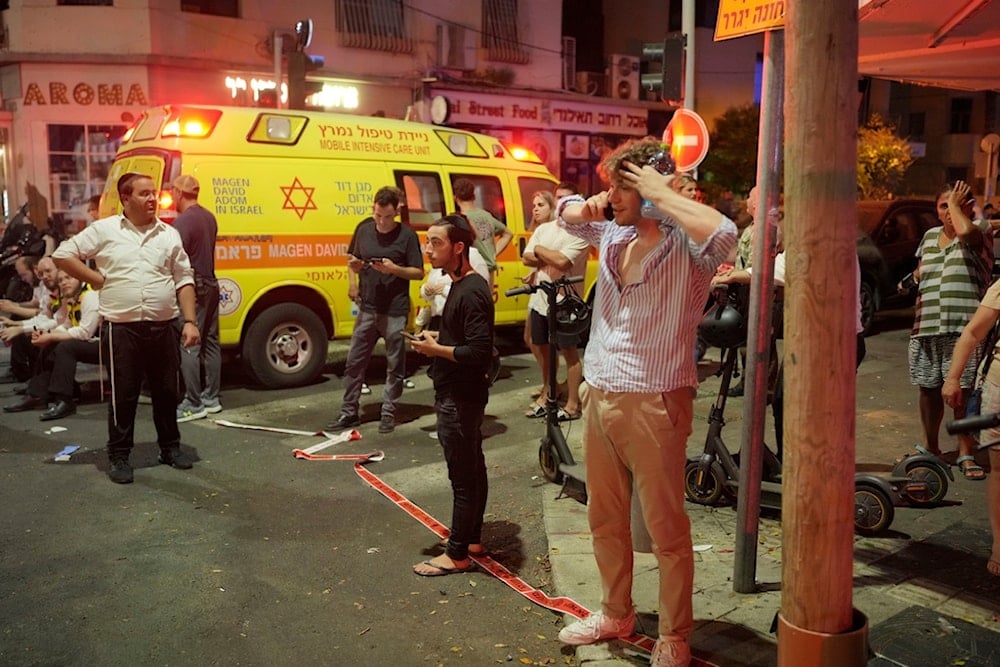Israeli media: Yemen's strike is 'October 7 of Israel's Air Defenses'
An Israeli military official details the problems the anti-air systems could have faced amid the failure to detect Yemen's drone, which struck Tel Aviv on Thursday.
-

People gather at the scene of Yemen's drone strike in Tel Aviv, occupied Palestine, early Friday, July 19, 2024. (AP)
Yemen's military operation that infiltrated Tel Aviv on Friday was coined an "October 7 of the Israeli Air Defenses," the Calcalist business and economics newspaper reported, citing a senior Israeli military official.
The Yemeni Armed Forces announced Friday a successful drone strike targeting a significant site in Tel Aviv, occupied Palestine, in continuation of their operations in support of Gaza.
The operation in question was conducted by the newly developed Yafa drone, Yemeni Armed Forces spokesperson Brigadier General Yahya Saree declared early Friday. The drone is named after the Palestinian city occupied by "Israel" as part of greater Tel Aviv.
The UAV is designed with the specific aim of evading enemy radar and interception systems, Saree said. The drone reached its target and achieved its operational objectives.
According to the official, Yemen's success in launching an attack drone deep into Tel Aviv was a "resounding failure" of the Israeli air defenses, representing "the end of the era of clean skies" that "Israel" took pride in for years.
He offered a blend of potential conditions and blows that could explain how the drone was able to penetrate occupied Palestine's airspace without any attempt at intercepting it, the primary theory being "a critical gap in tangible intelligence regarding the likes of the drone, which allowed it to travel at least 2,000 kilometers without being intercepted."
The problem with 'Israel's' air defense systems
The air defense system, according to the official, should have been equipped with an early trigger that would enable the deployment of ground and air defense systems to detect and identify the target, and then destroy it using defensive missiles, helicopters, or military aircraft.
In addition to the lack of such concrete information, “the Air Force’s defense system had other means that were supposed to help it detect the approaching threat, such as satellite detection, visual detection, and radars,” he added, which represents another failure.
He further clarified that the occupation's anti-air systems possess various visual equipment, many of which remain secret, but were supposed to aid the interception process when radars fail to detect the threat.
Moreover, the difficulty encountered when trying to obtain an authentic image of the sky by optical means during the operation could be related to the fact that the operation was carried out at night, which poses a challenge to those systems.
The drone's trip was also very lengthy and lasted several hours, which "misled Israeli systems, following changes in its altitude and route, until it finally arrived at Tel Aviv from the direction of the sea," the official noted.
"Israeli aerial superiority is no longer absolute in the absence of guaranteed protection of Israel's airspace," he said, adding that anyone who says otherwise is "lost and misled."
The threat on the northern front
Calcalist quoted the Israeli official as saying that last night's operation reshuffled the cards in a way that could indicate the beginning of an age during which settlers, anywhere they may be, could be exposed to dangers and at risk of a surprise air attack that cannot be pre-deterred.
In the same context, he said that the Air Force should determine whether the US forces, located in the Red Sea and the Gulf, detected any suspicious movements in the region, their nature, and what they had done about them, and if there were any gaps in coordination to be addressed, following an investigation into the failure.
Aside from the Yemeni drones, there are also complications in detection on the northern front amid the entry of more advanced drones into battle, which operate on quieter electric motors, according to the newspaper.
The possible scenarios adopted by the Israeli occupation army and the security establishment could also indicate that drone strikes on Gush Dan cities and important strategic installations in "Israel", such as the electricity infrastructure, “will become an integral part of the battle if the confrontation between Israel and Hezbollah enters the stage of a comprehensive war,” in addition to daily barrages of thousands of rockets and precision missiles with much greater destructive capabilities.
Read more: Hezbollah strikes Israeli bases, introduces new IRAM

 4 Min Read
4 Min Read








